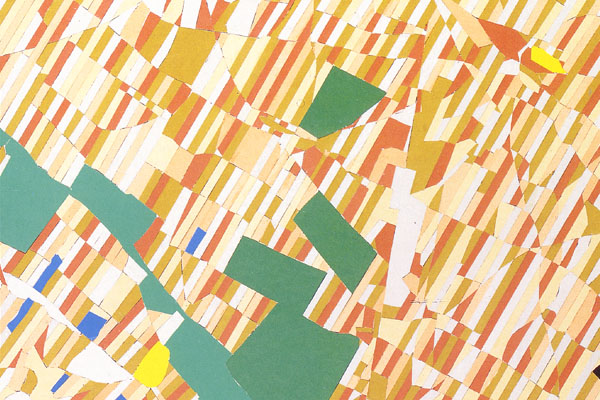…Monster, like the animal, is yet another category that features prominently of Derrida’s Geshlect 2. The term “monster” is for Derrida a “polysemic word” and not only represents familiar fairy tale creatures but references of course the socially and biologically abdominal along with the lesser considered French root of Montrer.
why monster? Not in order to make the thing pathetic, or because we are always near some monstrous Unheimlichkeit when we are prowling around the nationalist thing and the thing named Geshlecht. What is un monster? You know the polysemic gamut of this word. The uses one can make of it, for example concerning norms and forms, species and genus/gender: thus concerning geshlecht. I shall begin by privileging here another course [direction]. It goes in the direction, the sens, of a less known sense, since in French la monstre (a changing of gender sex, or geschlect) has the poetico-musical sense of a diagram that slows [montre] in a piece of music the number of versus and the number of syllables assigned to the poet. Monster is montrer (to show or demonstrate), and une monstre is montre (a watch). I am already settled in the untranslatable idiom of my language, for I certainly intend to speak to you about translation. La Monstre, then prescribes the divisions of a line or verse for a melody. Le Monstre is what shows in order to warn or put on guard. In the past la montre, in French was written la monstre.
Monster for Derrida is always at once referencing what he calls the geshlecht, (it’s futile to describe geshlecht here in any detail, but generally geshlecht is a sense of power-structures in a given time) but Derrida is also showing here that monsters and Monstrosity are closely linked to de-monstr-ate. Obviously the follow up question would be “What specifically does a Monster monstrate?” And while we might come back around to geshlecht, and the power structures of gender, race, nationality and politics already mentioned, there is more here related to the previous discussion of l’animal.
Monsters need very little definition. We all seem to know what constitutes a monster. In one sense they are the hideous and grotesque figures of childhood fairy tales. In another sense they are the socially unacceptable perpetrators of cultural abominations (rapists, serial killers and the like). What remains constant through these definitions however is that a monster is somehow unassimilable to the mass. Always on the outside, always misunderstood, and always “wholly other.” They are also, and we will need to be both vague and specific here, visible amalgamations of multiple organism. This is precisely why they remain other. Centaurs, Dragons, ogres, and Frankenstein are monstrous mainly because they are composites of man, and animal. Rapists, mass murderers and other socially and one might say, real-life monsters are also perversions of humanity, somehow more animalistic. Importantly they remain un-classifiable; neither human nor animal and as such lay bare the fiction of l’animal. Though it was perhaps never intended as such, Lear’s Scroobius Pip is just such a monster. Composed of parts of other species in a frankensteinian manner, radically different from his other animal kin, he is objectified and scrutinized. The pip, though he may not be violent or all that distasteful is on the outside of his social (animal sociality?) circle. Derrida’s apparently unmonsterous cat is just as frankensteinian and just as monstrous.
Donna Haraway in her work When Species Meet is quite clear about the fact that any one living thing is a gross amalgamation of multiple other living beings.
I love the fact that human genomes can be found in only about 10 percent of all the cells that occupy the mundane space I call my body; the other 90 percent of the cells are filled with the genomes of bacteria, fungi, protists and such. Some of which play in a symphony necessary to my being alive at all, and some of which are hitching a ride and doing the rest of me, of us, no harm. I am vastly outnumbered by my tiny companions; better put, I become an adult human being in company with these tiny messmates [my italics].
Derrida’s cat likewise is composed of a similarly disproportionate array of bacteria, protists and other “messmates.” Thus in fact, both stories, Derrida’s tale of shame in front of his feline friend and the pip’s grilling by his animal friends are in fact stories of monsters standing in the face of other monsters. Even Derrida himself, is a composite of multiple beings! So why are some monsters more locative than others? Why is it an issue? And more to the point what can any of us monsters say or show to one another? How do we respond? Certainly there seems to be a degree of scale at work here. The pip is visibly monstrous while the cat is not. But is monstrosity scalable? Derrida struggled with a monster that appeared to be a singular whole. The animal kingdom was befuddled by an apparent Frankenstein, and is there really any difference between the two? We now might find ourselves in an uncontrolled free-fall of animals within animals and nothing but monsters surrounding us. What to do? And this is precisely the point. I’d like to even further enlarge the definition of monster here to include not only independent multiplicities of animals but biological systems in general; to introduce perhaps the largest monster yet into the mix; the monstrosity of what we currently call Landscape. Only by seeing landscape as monstrous can we simultaneously access its wild, radical otherness and its demonstrability.







